Growing anxiety-reducing herbs indoors can help you create a calming sanctuary while providing natural remedies for stress. You'll find that lavender, chamomile, and lemon balm are particularly effective, as they contain compounds that interact with your body's stress response system. Holy basil and mint varieties offer additional mood-boosting benefits through their aromatherapeutic properties. The act of tending to these plants for just 15 minutes a day can greatly decrease your anxiety levels and improve your mood. By combining the therapeutic effects of gardening with these powerful herbs, you'll discover a holistic approach to managing daily stress.
Understanding Anxiety-Reducing Herbs
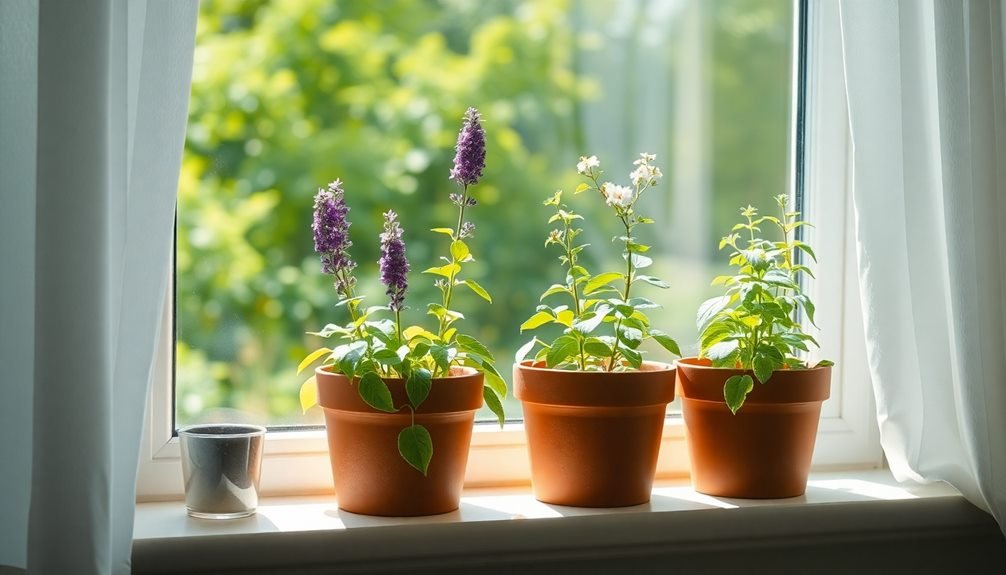
Many herbs contain natural compounds that interact with your body's stress response system, helping to calm nerves and reduce anxiety symptoms. These beneficial compounds include essential oils, flavonoids, and adaptogenic substances that can influence neurotransmitters and hormones related to stress and mood regulation.
You'll find that anxiety-reducing herbs typically work through different mechanisms. Some, like lavender and chamomile, contain compounds that bind to GABA receptors in your brain, promoting relaxation. Others, such as holy basil and ashwagandha, help regulate cortisol levels, your body's primary stress hormone.
Lemon balm contains rosmarinic acid, which can boost GABA activity and reduce stress-induced heart palpitations.
When choosing anxiety-reducing herbs, it's important to understand their potency and growing requirements. Fast-growing herbs like mint and lemon balm offer quick results, while slower-growing varieties like lavender require more patience but provide long-lasting benefits.
You'll need to take into account factors like light requirements, watering needs, and indoor temperature conditions to successfully grow these therapeutic plants. Each herb's unique properties and growing characteristics will influence its effectiveness in your anxiety management routine.
Benefits of Indoor Herb Gardens
Growing an indoor herb garden lets you connect with nature daily, providing a calming ritual that helps reduce stress and anxiety.
You'll have access to fresh, aromatic ingredients throughout the year, making it convenient to incorporate anxiety-reducing herbs into your daily wellness routine.
Your indoor herb garden also serves as a natural air purifier, as many herbs can help filter indoor air pollutants while releasing clean oxygen into your living space.
Stress Relief Through Nature
Bringing nature indoors can help calm your mind and reduce anxiety levels in powerful ways. When you tend to indoor herbs, you're creating a direct connection with the natural world, which triggers the release of feel-good hormones like serotonin and dopamine. The simple act of caring for plants can lower your cortisol levels, reducing stress and promoting relaxation.
You'll find that working with indoor herbs engages multiple senses: the tactile experience of touching soil and leaves, the visual pleasure of watching plants grow, and the aromatic benefits of fragrant herbs. This multisensory engagement helps ground you in the present moment, similar to mindfulness meditation.
Studies show that just 15 minutes of indoor gardening can considerably decrease stress levels and improve mood.
The presence of greenery in your living space also improves air quality and humidity levels, creating a healthier environment that supports your overall well-being. You're not just growing plants; you're cultivating a peaceful sanctuary that provides both immediate and long-term stress relief.
This natural approach to anxiety management fits seamlessly into your daily routine, offering therapeutic benefits whenever you need them.
Year-Round Fresh Ingredients
Beyond their calming effects, indoor herb gardens provide you with a constant supply of fresh ingredients throughout the year.
You'll save money by not purchasing expensive packaged herbs from grocery stores, and you'll have immediate access to fresh flavors whenever you need them. Growing your own herbs guarantees they're pesticide-free and at peak freshness when you harvest them.
Many anxiety-reducing herbs double as culinary staples. You can snip fresh basil for your pasta dishes, add mint to your tea, or garnish your meals with fresh parsley.
Rosemary and thyme aren't just aromatherapeutic – they're essential seasonings for many recipes. Sage, which can help reduce stress, adds depth to savory dishes and stuffings.
Your indoor herb garden allows you to experiment with less common varieties you mightn't find at stores.
Try different types of mint, such as chocolate or pineapple mint, or explore various basil cultivars like Thai or lemon basil.
You can also dry excess herbs to create your own tea blends or spice mixtures, extending their usefulness beyond the growing season.
Natural Air Purification Benefits
In addition to their calming properties, indoor herbs act as natural air purifiers for your living space. Through photosynthesis, these plants absorb carbon dioxide and release fresh oxygen, improving your home's air quality.
They'll also filter out common indoor pollutants like benzene, formaldehyde, and xylene, which can off-gas from furniture and cleaning products.
Certain herbs are particularly effective air purifiers. Lavender removes airborne bacteria while releasing its signature soothing scent.
Rosemary filters out harmful toxins and releases compounds that can boost your mood and cognitive function.
Lemon balm and mint varieties excel at removing indoor air pollution while providing revitalizing aromas that can help clear your mind.
You'll maximize these air-purifying benefits by placing your herbs strategically throughout your home.
Position them near windows where they'll receive adequate light and can actively filter incoming air.
Group several herbs together in areas where you spend the most time, such as your home office or bedroom.
For ideal air filtration, maintain healthy plants by keeping their leaves dust-free and providing proper water and nutrients.
Essential Tools and Materials
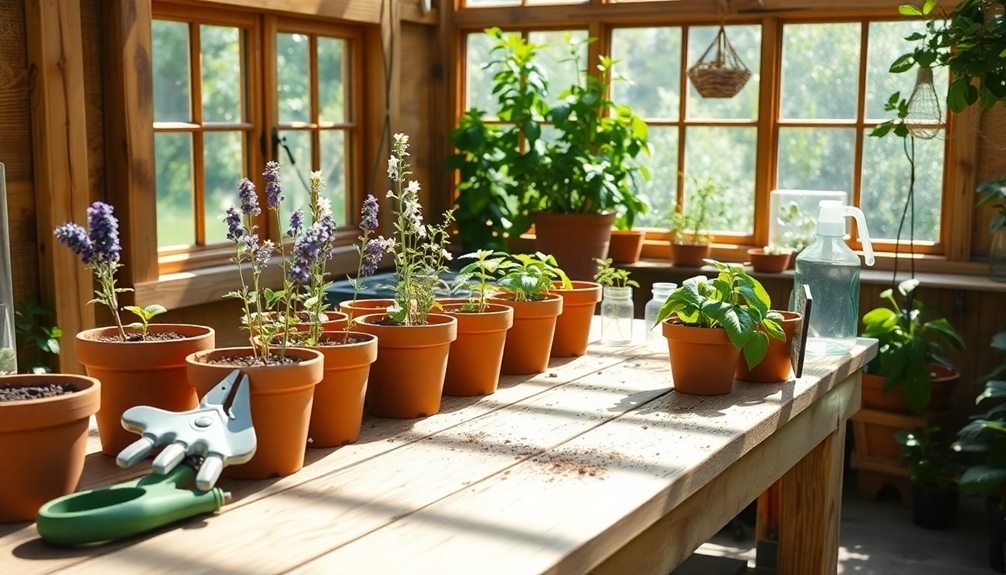
Growing anxiety-reducing herbs indoors requires five basic tools to guarantee success. You'll need containers with drainage holes, high-quality potting soil specifically formulated for herbs, a watering can with a narrow spout, pruning shears, and a spray bottle for misting.
Each container should be at least 6 inches deep and wide enough to accommodate your chosen herb's root system.
Select a potting mix that contains perlite and vermiculite to ensure proper drainage and aeration. Your watering can should have a long, narrow spout to deliver water directly to the soil without splashing the leaves.
Keep your pruning shears clean and sharp to harvest herbs and remove dead foliage without damaging the plants. The spray bottle helps maintain humidity levels, which is vital for moisture-loving herbs like mint and basil.
You'll also benefit from having plant markers to identify different herbs, a soil moisture meter to prevent overwatering, and a natural fertilizer suitable for edible plants.
Consider adding a grow light if your indoor space doesn't receive adequate natural sunlight, especially during winter months.
Ideal Growing Conditions
While each anxiety-reducing herb has unique requirements, most indoor varieties thrive in similar baseline conditions. You'll want to maintain temperatures between 65-70°F (18-21°C), as most herbs prefer moderate warmth. Guarantee good air circulation to prevent mold and maintain healthy growth.
Your herbs will need at least 6 hours of daily light. Place them near south or west-facing windows for ideal natural sunlight. If you're using grow lights, position them 6-12 inches above the plants.
You'll need well-draining potting soil specifically formulated for herbs, and containers with drainage holes to prevent root rot. Monitor soil moisture by touching the surface – water when it feels dry about an inch deep. Don't overwater, as most anxiety-reducing herbs prefer slightly dry conditions over soggy soil.
Maintain humidity levels between 40-60% by misting or using a humidity tray. Feed your herbs monthly with a balanced, water-soluble fertilizer during the growing season. Reduce feeding in winter when growth naturally slows.
Prune regularly to encourage bushier growth and prevent flowering, which can make leaves bitter and less effective.
Best Herbs for Stress Relief
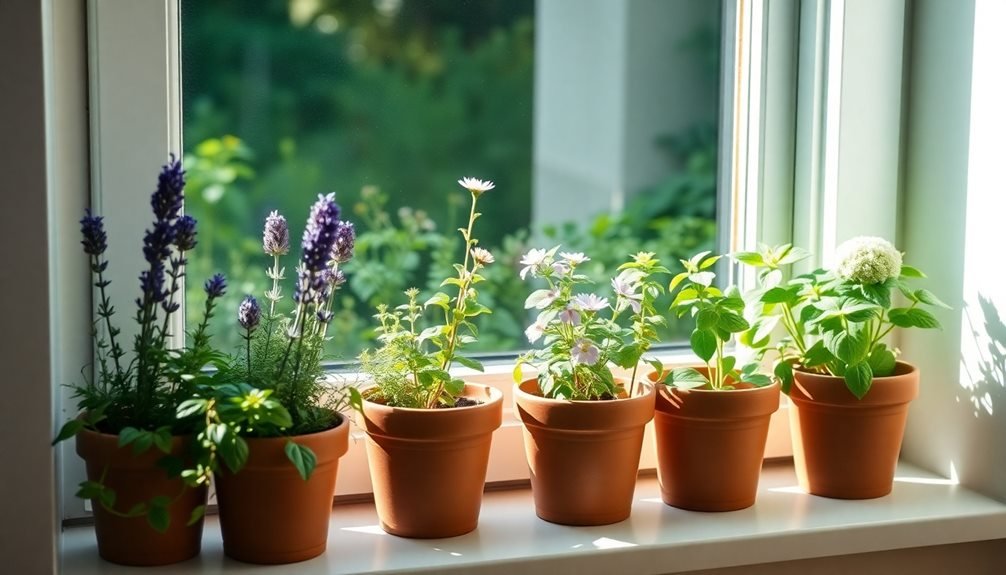
Several research-backed herbs can help you manage anxiety when grown indoors, including calming lavender, stress-reducing chamomile, and mood-lifting lemon balm.
You'll want to focus on these powerhouse plants since they're both easy to grow and clinically proven to lower cortisol levels.
Growing multiple varieties together creates a natural stress-relief garden that you can access year-round, right from your windowsill.
Science-Backed Calming Herbs
Research has confirmed that certain indoor herbs can effectively reduce anxiety and stress through their natural compounds. Several well-studied herbs have demonstrated significant calming properties in clinical trials and scientific research.
Lavender contains linalool and linalyl acetate, compounds proven to interact with neurotransmitters that regulate mood and stress response.
You'll find that chamomile's apigenin content helps reduce anxiety by binding to specific receptors in your brain, while holy basil's adaptogenic properties can lower cortisol levels and improve stress resilience.
Studies show that lemon balm's rosmarinic acid content enhances GABA activity, promoting relaxation and reducing nervous tension.
You can also benefit from sage's antioxidant compounds, which have been linked to improved mood and cognitive function.
Rosemary's active compounds, including carnosic acid and rosmarinic acid, have demonstrated anxiety-reducing effects in controlled studies.
When you're growing these herbs indoors, they'll release beneficial volatile compounds into your environment.
The combination of their therapeutic properties and the mindful activity of gardening creates a scientifically supported approach to anxiety management.
Growing Tips For Success
Getting started with anxiety-reducing herbs requires careful attention to their specific growing needs. Most calming herbs prefer well-draining soil and at least 6 hours of direct sunlight daily. You'll need containers with drainage holes and high-quality potting mix specifically formulated for herbs.
Place your herbs near south or west-facing windows for best light exposure. If natural light is limited, consider using LED grow lights positioned 6-12 inches above the plants. Water your herbs when the top inch of soil feels dry, but don't overwater as this can lead to root rot.
Temperature control is essential – most anxiety-reducing herbs thrive in temperatures between 65-70°F. Maintain good air circulation by spacing plants properly and using a small fan if needed.
Feed your herbs monthly with a balanced, water-soluble fertilizer during the growing season.
Harvest your herbs regularly to encourage bushier growth. Cut stems just above a leaf node, taking no more than one-third of the plant at a time. For maximum potency, harvest in the morning after the dew has dried but before the day heats up.
Daily Care and Mindfulness
Caring for your indoor herb garden can become a therapeutic daily ritual that naturally reduces anxiety. As you tend to your plants each morning, focus on being present in the moment and connecting with nature, even from inside your home.
The gentle routine of checking soil moisture, removing dead leaves, and observing new growth can ground you and create a sense of calm.
To make your daily herb care practice more mindful:
- Start each morning by taking three deep breaths near your herbs, inhaling their natural aromatherapy while gently touching their leaves.
- When watering, pay attention to how the soil darkens and absorbs moisture – use this time to mentally let go of any worries or stress.
- Spend a few minutes pruning and harvesting with intention, expressing gratitude for the herbs' growth and their beneficial properties.
- End your care routine by misting the leaves, watching the water droplets catch the light, and visualizing your anxiety dissolving like the mist.
This mindful approach transforms basic plant maintenance into a calming practice that benefits both you and your herbs, creating a positive cycle of growth and wellness.
Herb Garden Layout Design
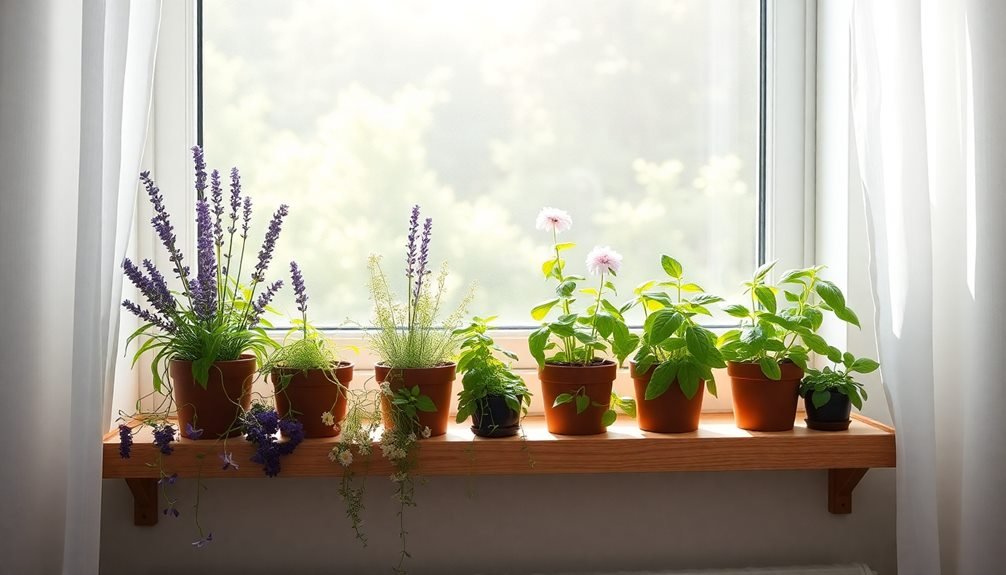
When planning your indoor herb garden layout, thoughtful design can maximize both the calming benefits and growing success of your anxiety-reducing plants. Arrange taller herbs like rosemary and lavender at the back of your growing space, while keeping low-growing plants like thyme and chamomile in front for easy access and visual balance.
Create distinct zones based on light requirements, placing sun-loving herbs like basil and sage in south-facing windows, while positioning shade-tolerant plants like mint and lemon balm in areas with filtered light.
You'll want to group herbs with similar watering needs together to streamline maintenance and prevent over or under-watering.
Consider using tiered shelving or vertical garden systems to maximize space and create a visually appealing display that draws your eye upward, promoting a sense of calm.
Don't forget to leave enough space between plants for proper air circulation and growth. Add small paths or access points between containers so you can easily tend to each plant, making your gardening routine more enjoyable and less stressful.
Label each plant clearly to maintain organization and reduce confusion during care routines.
Propagation Methods for Beginners
Starting your own anxiety-reducing herbs from existing plants can be both rewarding and cost-effective.
You'll find that most calming herbs like lavender, mint, and chamomile can be propagated through simple methods that don't require advanced gardening skills.
With proper timing and care, you can multiply your existing plants and create a robust indoor herb garden dedicated to stress relief.
The most beginner-friendly propagation methods for anxiety-reducing herbs include:
- Water propagation – Place healthy stem cuttings in clean water, changing it every few days until roots develop. This works especially well for mint, basil, and lemon balm.
- Stem cuttings in soil – Cut 4-6 inch stems just below a leaf node, remove lower leaves, dip in rooting hormone, and plant in moist potting mix. Perfect for lavender and rosemary.
- Division – Separate established plants like lemon grass and chamomile into smaller sections, ensuring each has healthy roots and shoots.
- Layering – Bend flexible stems to the soil while still attached to the parent plant, securing with pins until roots form. This method's ideal for trailing herbs like thyme.
Seasonal Care and Maintenance
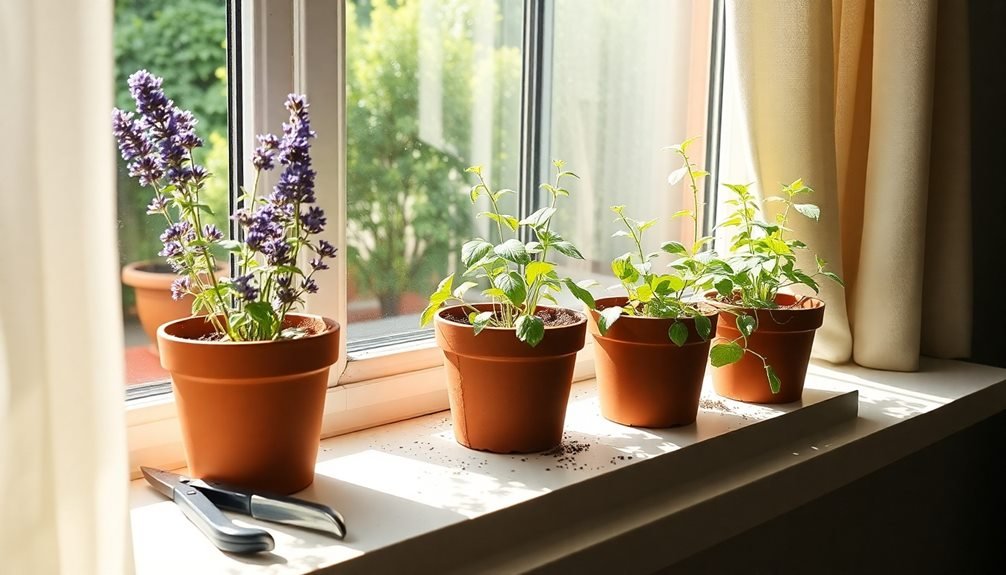
Throughout the year, your indoor anxiety-reducing herbs will need specific care adjustments to stay healthy and potent.
During spring and summer, you'll need to water more frequently, typically every 2-3 days, as your herbs experience increased growth. You'll also want to rotate your pots weekly to guarantee even light exposure and prevent leggy growth.
In fall and winter, reduce watering to once every 4-5 days, as most herbs enter a semi-dormant state. You'll need to compensate for shorter daylight hours by moving plants closer to windows or supplementing with grow lights for 6-8 hours daily.
Keep your herbs away from cold drafts and maintain room temperatures between 65-70°F.
Year-round, you should prune regularly to encourage bushier growth and prevent flowering, which can make leaves bitter. Remove any yellowing leaves immediately to prevent disease spread.
Monitor humidity levels, aiming for 40-60% – use a pebble tray or small humidifier if needed. Feed your herbs with organic liquid fertilizer every 4-6 weeks during growing season, but cut back to every 8-10 weeks in winter months.
Harvesting and Using Calming Herbs
Proper harvesting techniques maximize both your herbs' therapeutic benefits and their continued growth.
You'll want to harvest your calming herbs in the morning after the dew has dried but before the day's heat sets in. This timing guarantees the highest concentration of essential oils in the leaves. Use clean, sharp scissors to make precise cuts, removing no more than one-third of the plant at a time.
For anxiety-reducing benefits, you can use your harvested herbs in several effective ways:
- Create a calming tea by steeping fresh lavender, lemon balm, or chamomile flowers in hot water for 5-10 minutes.
- Make an herb-infused pillow by drying mint, lavender, or rosemary and placing them in a small fabric pouch.
- Add fresh basil or sage leaves to your bathwater for a relaxing, aromatherapeutic soak.
- Crush fresh herbs between your fingers while gardening to release their soothing essential oils.
Store excess fresh herbs in the refrigerator, wrapped in slightly damp paper towels, or dry them by hanging small bundles upside down in a well-ventilated, dark area.
Remember to label and date your stored herbs for future use.
Frequently Asked Questions
Can Indoor Herb Gardening Trigger Allergies or Worsen Anxiety Symptoms?
Yes, you can experience allergic reactions to certain herbs, and soil dust might trigger symptoms. If you're sensitive, wear gloves and a mask while gardening. Start small to avoid feeling overwhelmed with maintenance.
How Long Does It Take to Notice Mental Health Benefits?
You'll typically notice gardening's calming effects within 15-30 minutes of tending plants. However, long-term mental health benefits develop over 4-6 weeks of regular interaction with your indoor garden and its routines.
Which Herbs Should Not Be Grown Together Due to Conflicting Properties?
You'll want to keep mint separate from other herbs as it's invasive. Don't plant basil near rue, and keep fennel away from most herbs. Sage and thyme can clash with each other.
Do Artificial Grow Lights Affect the Anxiety-Reducing Properties of Herbs?
You won't lose any anxiety-reducing benefits when using grow lights. In fact, they'll help your herbs thrive year-round, which means you'll have constant access to their calming properties through gardening and consumption.
Are There Any Herbs That Help With Anxiety but Are Toxic to Pets?
You'll want to avoid lavender, valerian root, and chamomile if you've got pets. While these herbs can calm anxiety, they're toxic to cats and dogs. Stick to pet-safe alternatives like lemon balm instead.
In Summary
Growing anxiety-reducing herbs indoors isn't just therapeutic – you'll reap the rewards of both gardening and herbal remedies. Start with lavender, chamomile, and lemon balm for their proven calming effects. Remember to tend to your indoor garden daily, as the routine itself helps reduce stress. Whether you're steeping tea or simply enjoying their fragrance, your indoor herb garden will become your personal sanctuary for peace and relaxation.

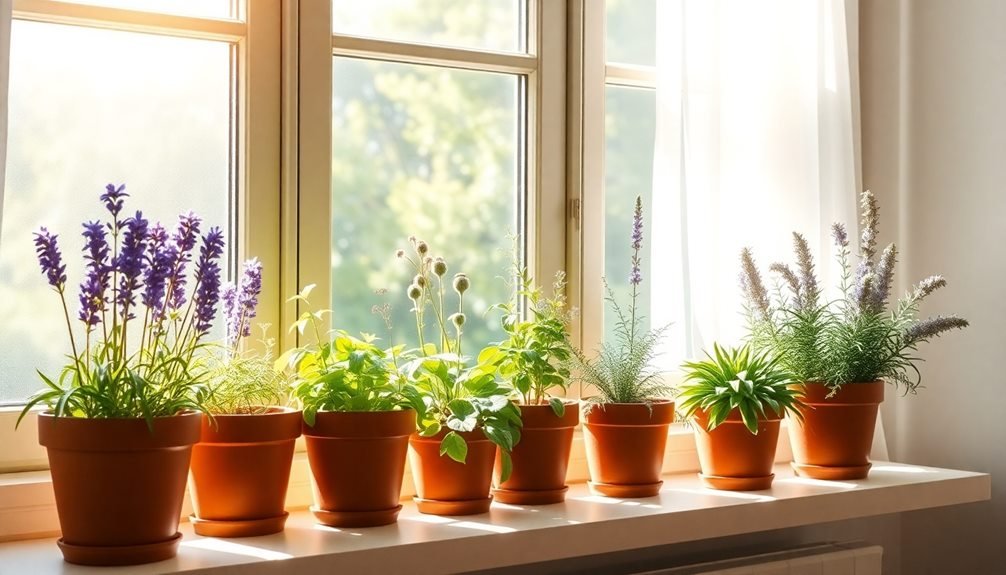



Leave a Reply